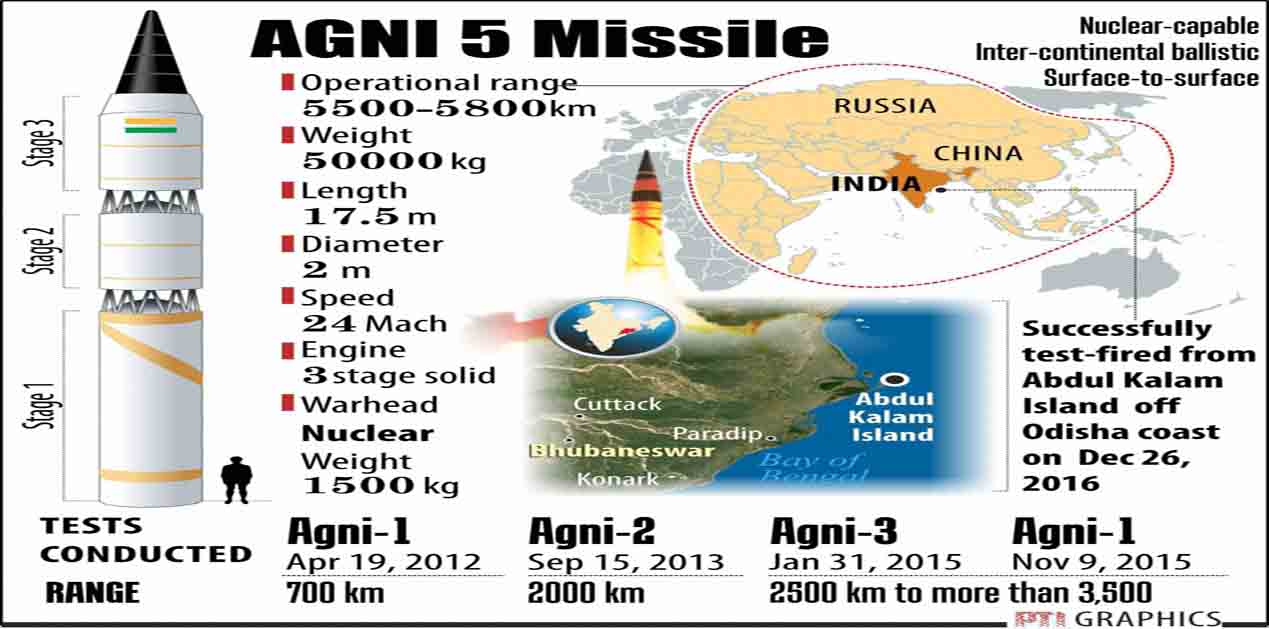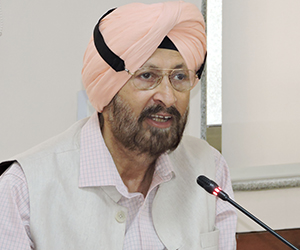On January 18, 2018, the personnel of the Indian armed forces test-fired the 5,000-km-plus Agni-5 Interim Range Ballistic Missile (IRBM). The test, conducted from Kalam Island in the Bay of Bengal, achieved all the mission parameters that had been stipulated. The last test of Agni-5 had been conducted on December 26, 2016. After additional user trials over the next twelve to eighteen months, the nuclear-capable Agni-5 missile will be inducted into India’s Strategic Forces Command (SFC). Normally, five to seven tests are carried out, including technical trials and user trials, before a missile is inducted into the arsenal. On the operationalisation of Agni-5, all targets in China will come within range from India. The Chinese are reported to be concerned at this development.
The 4,000-km Agni-4 IRBM was successfully test-fired by personnel of the SFC from the same launch facility on January 2, 2017. After these two tests, the credibility of India’s nuclear deterrence received a good boost.
Under the aegis of its Integrated Guided Missile Development Programme (IGMDP), which was approved by the Government on 26 July 1983, India has achieved considerable success in ballistic missile development. The Prithvi Short Range Ballistic Missile (SRBM) (1-metre diameter, 150 km to 350 km range, liquid-fuelled) and the multiple models of Agni IRBM (800 km to 5,000 km range, solid-fuelled) have provided India with an assured retaliation capability. Though exact details are not known in the public domain, DRDO spokespersons have shared sufficient information to allow for an assessment of the missiles’ capabilities. While the Agni-5 is still under development, the Agni- 4 is reported to be ready for deployment. According to a Ministry of Defence press release, ‘Agni-3 was inducted to strengthen India’s strategic might and joined Agni-1, Agni-2, Prithvi-2 and Dhanush (the naval version of Prithvi capable of being launched from ships even under rough sea conditions).’
Agni IRBMs are the mainstay of the surface-to-surface leg of India’s strategic forces. With the exception of the Agni-1, all Agni missiles are fully solid-fuelled with carbon composite heat shields for re-entry protection. All of the Agni variants are known to be extremely accurate and use navigation systems based on a combination of ring laser gyros and inertial navigation. Presently, at least two Agni missile groups are reported to be in service.
India’s successful experience in space research, particularly the launch of multiple satellites on a single rocket, has endowed the scientists with the capability to master MIRV (multiple independently targetable re-entry vehicles) technology. In view of the R&D developments in China, it was considered expedient to commence a research programme on MIRV systems as a technology demonstrator. Costing Rs. 100 crore per missile, the Agni-5, with a range of 5,000 km-plus, is known to be capable of carrying MIRV warheads. At its maximum range, the Agni-5 can reach even Harbin, China’s northernmost city (according to Chinese officials, the maximum range of Agni-5 is 8,000 km). A canisterised version of the Agni-5 was first test-fired on January 15, 2015. The process of canisterisation means the warhead will be mated with the missile for storage, not stored separately and mounted on the missile shortly before launch.
Dr V K Saraswat, a former DRDO chief, said the Agni-5 had ‘ushered in fantastic opportunities in…building Anti-Satellite (ASAT) weapons and launching mini/micro satellites on demand’. The Agni-5, like Dongfeng 31A, is a canisterised, road mobile missile. According to Avinash Chander, director, Advanced Systems Laboratory, Hyderabad, ‘With the canister having been successfully developed, all India’s future land-based strategic missiles will be canisterised as well.’ The DRDO is also reported to have plans to develop the Agni-6 Inter-Continental Ballistic Missile (ICBM), which will be capable of carrying a 3-ton payload of MIRVs and manoeuvrable re-entry vehicles (MaRVs). The range of this missile, made of light weight composite materials, is expected to be over 5,500 km. However, the existence of such a programme has been officially denied.
Prithvi-1 (150 km-range), Prithvi-2 (250 km, IAF version) and Prithvi-3 (350 km) Surface to Surface Missiles (SSM) are all nuclear-capable. Prithvi missiles are liquid fuelled with strap-down inertial guidance and a manoeuvrable trajectory; accuracies are claimed to be in single digits and the circular error probability (CEP) is likely to be less than 100 metre. These dual-use missiles are capable of carrying 500 kg to 1,000 kg warheads. It is now being increasingly believed that the Prithvi-1 missile was never intended to carry nuclear warheads. Six Prithvi missile groups are reported to be in service.
As soon as the Agni-1 regiments are fully operational and the missiles have been produced in the required numbers, it should be possible to retire the Prithvi missiles from service with the SFC. However, these missiles are likely to continue to be used for conventional conflict and as part of the ballistic missile defence (BMD) technology development programme till these become obsolete. A modified Prithvi missile is the interceptor in the Prithvi Air Defence (PAD) system for exo-atmospheric interception. It is also used as a target for an incoming missile.
India has a few other missiles in its arsenal. The Dhanush SSM is a ship-to-surface variant of Prithvi-3 with a maximum range of 350 km, while Nirbhay is a subsonic (Mach 0.7) cruise missile with a maximum range of 1,000 km. Of the Tomahawk and Kh-57 class, it carries a 450 kg high-explosive warhead and was successfully tested in November 2017. Prahar is a highly manoeuvrable, precision-strike tactical SSM with a range of 150 km and is armed with a conventional warhead. Comparable to the US Army Tactical Missile System (ATACMS), it has been conceived as a quick-reaction battlefield support weapon system that fills the range gap between multi-barrel rocket launchers (MBRLs) and SRBMs. All of these missiles have been indigenously developed by the Aeronautical Development Establishment (ADE), Bengaluru, and have been produced by Bharat Dynamics Limited (BDL), Secunderabad. The rate of production of Agni missiles is reported to be twelve to eighteen per annum.
India does not maintain its missile launchers on hair-trigger alerts as India’s ‘no first use’ posture does not require launch-on-warning (LoW) and launch-through-attack (LTA) capabilities. Alert levels are planned to be progressively raised based on intelligence inputs or for the purpose of signalling. As India shares its western boundary with Pakistan, the time of flight of ballistic missiles ranges from eight to thirteen minutes for a target between 600 km and 2,000 km away. Deployment sites – hides and firing positions – are selected keeping this in mind, besides other tactical parameters. Depending on the level of alert being maintained, preparation time for launch can vary from one to four hours. When deployed, missile batteries would be provided logistics support by the nearest field formation of the Army and helped with their local defence where feasible.
(The writer is Visiting Fellow, VIF and Distinguished Fellow, Institute for Defence Studies and Analyses (IDSA), New Delhi)
(Views expressed are of the author and do not necessarily reflect the views of the VIF)
Image Source: https://s3.scoopwhoop.com/anj/vashvajhvajvspysyhxfuysfgxsshsvshhsshhdsssrdtfyghfgyRituTiwari/934911058.jpg








.jpg)


Post new comment